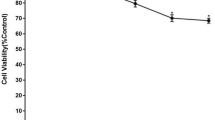Abstract
Background
The aim of this study was to evaluate the renal preservation effect of ubiquinol, the reduced form of coenzyme Q10 (CoQ10).
Methods
Three-week-old heminephrectomized male Sprague–Dawley rats were divided into three groups (10 animals each): diet with normal (0.3%) salt, high (8%) salt, and high salt plus 600 mg/kg body weight/day of ubiquinol, for 4 weeks. Systolic blood pressure (SBP), urinary albumin (u-alb), superoxide anion generation (lucigenin chemiluminescence) and ubiquinol levels in renal tissues were examined.
Results
Salt loading increased SBP (111.0 ± 3.6 vs. 169.4 ± 14.3 mmHg, p < 0.01) and u-alb (43.8 ± 28.0 vs. 2528.7 ± 1379.0 µg/day, p < 0.02). These changes were associated with stimulation of superoxide generation in the kidney (866.3 ± 102.8 vs. 2721.4 ± 973.3 RLU/g kidney, p < 0.01). However, ubiquinol decreased SBP (143.9 ± 29.0 mmHg, p < 0.05), u-alb (256.1 ± 122.1 µg/day, p < 0.02), and renal superoxide production (877.8 ± 195.6 RLU/g kidney, p < 0.01), associated with an increase in renal ubiquinol levels.
Conclusion
Ubiquinol, the reduced form of CoQ10, effectively ameliorates renal function, probably due to its antioxidant effect. Thus, ubiquinol may be a candidate for the treatment of patients with kidney disease.

Similar content being viewed by others
References
Lysaght J. Maintenance dialysis population dynamics: current trends and long-term implications. J Am Soc Nephrol. 2002;13(Suppl):S37–40.
National Kidney Foundation. K/DOQI clinical practice guidelines for chronic kidney disease: evaluation, classification, and stratification. Am J Kidney Dis. 2002;39(2 Suppl 1):S1–266.
Go AS, Chertow GM, Fan D, McCulloch CE, Hsu CY. Chronic kidney disease and the risks of death, cardiovascular events, and hospitalization. N Engl J Med. 2004;351:1296–305.
Cachofeiro V, Goicochea M, de Vinuesa SG, Oubina P, Lahera V, Luno J. Oxidative stress and inflammation, a link between chronic kidney disease and cardiovascular disease. Kidney Int. 2008;74(Suppl):S4–9.
Nagase M, Yoshida S, Shibata S, Nagase T, Gotoda T, Ando K, et al. Enhanced aldosterone signaling in the early nephropathy of rats with metabolic syndrome: possible contribution of fat-derived factors. J Am Soc Nephrol. 2006;17:3438–46.
Liu F, Wei CC, Wu SJ, Chenier I, Zhang SL, Filep JG, et al. Apocynin attenuates tubular apoptosis and tubulointerstitial fibrosis in transgenic mice independent of hypertension. Kidney Int. 2009;75:156–66.
Manning RD Jr, Tian N, Meng S. Oxidative stress and antioxidant treatment in hypertension and the associated renal damage. Am J Nephrol. 2005;25:311–7.
Hosoe K, Kitano M, Kishida H, Kubo H, Fujii K, Kitahara M. Study on safety and bioavailability of ubiquinol (Kaneka QH) after single and 4-week multiple oral administration to healthy volunteers. Regul Toxicol Pharmacol. 2007;47:19–28.
Carlström M, Sällström J, Skøtt O, Larsson E, Persson AE. Uninephrectomy in young age or chronic salt loading causes salt-sensitive hypertension in adult rats. Hypertension. 2007;49:1342–50.
Kitano M, Watanabe D, Oda S, Kubo H, Kishida H, Fujii K, et al. Subchronic oral toxicity of ubiquinol in rats and dogs. Int J Toxicol. 2008;27:189–215.
Matsui H, Shimosawa T, Uetake Y, Wang H, Ogura S, Kaneko T, et al. Protective effect of potassium against the hypertensive cardiac dysfunction: association with reactive oxygen species reduction. Hypertension. 2006;48:225–31.
Kishimoto C, Tomioka N, Nakayama Y, Miyamoto M. Anti-oxidant effects of coenzyme Q10 on experimental viral myocarditis in mice. J Cardiovasc Pharmacol. 2003;42:588–92.
Bello RI, Gómez-Díaz C, Burón MI, Alcaín FJ, Navas P, Villalba JM. Enhanced anti-oxidant protection of liver membranes in long-lived rats fed on a coenzyme Q10-supplemented diet. Exp Gerontol. 2005;40:694–706.
Mohr D, Umeda Y, Redgrave TG, Stocker R. Antioxidant defenses in rat intestine and mesenteric lymph. Redox Rep. 1999;4:79–87.
Lim SC, Tan HH, Goh SK, Subramanian T, Sum CF, Tan IK, et al. Oxidative burden in prediabetic and diabetic individuals: evidence from plasma coenzyme Q10. Diabet Med. 2006;23:1344–9.
Yamamoto Y, Yamashita S. Plasma ubiquinone to ubiquinol ratio in patients with hepatitis, cirrhosis, and hepatoma, and in patients treated with percutaneous transluminal coronary reperfusion. Bio Factors. 1999;9:241–6.
Iwamoto Y, Yamagami T, Folkers K, Blomqvist CG. Deficiency of coenzyme Q10 in hypertensive rats and reduction of deficiency by treatment with coenzyme Q10. Biochem Biophys Res Commun. 1974;58:743–8.
Mori TA, Burke V, Puddey I, Irish A, Cowpland CA, Beilin L, et al. The effects of [omega]3 fatty acids and coenzyme Q10 on blood pressure and heart rate in chronic kidney disease: a randomized controlled trial. J Hypertens. 2009;27:1863–72.
Ho MJ, Bellusci A, Wright JM. Blood pressure lowering efficacy of coenzyme Q10 for primary hypertension. Cochrane Database Syst Rev. 2009;4:CD007435.
Aberg F, Appelkvist EL, Dallner G, Ernster L. Distribution and redox state of ubiquinones in rat and human tissues. Arch Biochem Biophys. 1992;295:230–4.
Kawarazaki H, Ando K, Nagae A, Fujita M, Matsui H, Fujita T. Mineralocorticoid receptor activation contributes to salt-induced hypertension and renal injury in prepubertal Dahl salt-sensitive rats. Nephrol Dial Transplant; 2010 (in press).
Kido M, Ando K, Onozato ML, Tojo A, Yoshikawa M, Ogita T, et al. Protective effect of dietary potassium against the vascular injury in salt-sensitive hypertension. Hypertension. 2008;51:225–31.
Gregg D, Rauscher FM, Goldschmidt-Clermont PJ. Rac regulates cardiovascular superoxide through diverse molecular interactions: more than a binary GTP switch. Am J Physiol Cell Physiol. 2003;285:C723–34.
Vaziri ND, Wang XQ, Oveisi F, Rad B. Induction of oxidative stress by glutathione depletion causes severe hypertension in normal rats. Hypertension. 2000;36:142–6.
Author information
Authors and Affiliations
Corresponding author
About this article
Cite this article
Ishikawa, A., Kawarazaki, H., Ando, K. et al. Renal preservation effect of ubiquinol, the reduced form of coenzyme Q10. Clin Exp Nephrol 15, 30–33 (2011). https://doi.org/10.1007/s10157-010-0350-8
Received:
Accepted:
Published:
Issue Date:
DOI: https://doi.org/10.1007/s10157-010-0350-8




